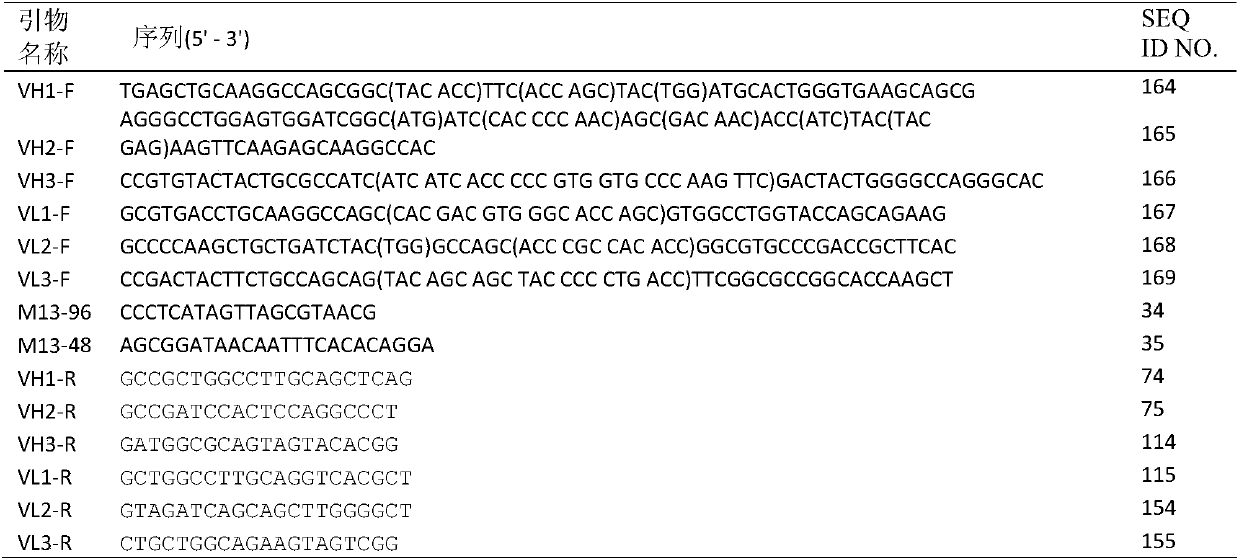High-affinity anti-MSLN antibody and applications thereof
A technology of antibody and carrier, applied in the field of biomedicine, can solve the problems of high mortality rate, less than 6%, lack of
- Summary
- Abstract
- Description
- Claims
- Application Information
AI Technical Summary
Problems solved by technology
Method used
Image
Examples
preparation example Construction
[0192] Preparation of monoclonal antibodies
[0193] Antibodies of the present invention can be prepared by various techniques known to those skilled in the art. For example, an antigen of the invention may be administered to an animal to induce the production of monoclonal antibodies. For monoclonal antibodies, hybridoma technology can be used to prepare (see Kohler et al., Nature 256; 495, 1975; Kohler et al., Eur.J.Immunol.6:511, 1976; Kohler et al., Eur.J.Immunol. 6:292,1976; Hammerling et al., In Monoclonal Antibodies and T Cell Hybridomas, Elsevier, N.Y., 1981) or can be prepared by recombinant DNA methods (US Patent No. 4,816,567).
[0194] Representative myeloma cells are those that fuse efficiently, support stable high-level production of antibody by selected antibody-producing cells, and are sensitive to culture medium (HAT medium matrix), including myeloma cell lines, such as murine Myeloma cell lines, including those derived from MOPC-21 and MPC-11 mouse tumors (...
Embodiment 1
[0226] Example 1. Construction of CDR1, CDR2, and CDR 3 mutation libraries of heavy chain (H) and light chain (L) of MN single-chain antibody
[0227] Using the pCAN-scFv MN plasmid (purchased from GE) as a template, mutations were introduced by PCR with random primers, and the primers are shown in Table 1. The obtained PCR products of the heavy chain (H) and light chain (L) of the scFv MN CDR1, CDR2, and CDR3 mutation library were named H1, H2, H3, L1, L2, and L3, respectively. After the PCR product and pCANTAB 5E were digested and recovered with Sfi I and Not I, they were ligated overnight at 16°C with T4 DNA ligase. The ligation product was electroporated to TG1, resuspended in 2YT and recovered at 37°C for 1 hour, then the bacterial solution was taken for gradient dilution and plate counting, and the storage capacity of each mutant library was at least 108, and the rest of the bacterial solution was all coated with 2YT (GA: 5% glucose, 100ug / ml penicillin) plate. 20 sin...
Embodiment 2
[0230] Example 2. Panning of phage antibody library
[0231] Add 20nM MSLN-Fc-biotin antigen (MSLN was purchased from SinoBiological; Biotin labeling reagent was purchased from Sigma) and incubate with the phage antibody library at room temperature for 2h, then transfer the mixture to streptavidin magnetic beads (purchased from LifeTechnology) and incubate at room temperature 15min. Unbound phages were washed away with PBST-PBS, and trypsin was added for 30 min at 37°C to elute bound phages. Infect 4ml of TG1 cells in the logarithmic phase with the phages digested and eluted by trypsin, let stand at 37°C for 30 minutes, take part of the bacterial liquid to serially dilute for plate counting, and coat the rest of the bacterial liquid on 2YT (GA) plates for next A round of packaging. The packaged phages can be used for the next round of panning. A total of 4 rounds of panning and enrichment were carried out. In each round of panning, 10-fold dilution gradients decreased the an...
PUM
| Property | Measurement | Unit |
|---|---|---|
| concentration | aaaaa | aaaaa |
Abstract
Description
Claims
Application Information
 Login to View More
Login to View More - R&D
- Intellectual Property
- Life Sciences
- Materials
- Tech Scout
- Unparalleled Data Quality
- Higher Quality Content
- 60% Fewer Hallucinations
Browse by: Latest US Patents, China's latest patents, Technical Efficacy Thesaurus, Application Domain, Technology Topic, Popular Technical Reports.
© 2025 PatSnap. All rights reserved.Legal|Privacy policy|Modern Slavery Act Transparency Statement|Sitemap|About US| Contact US: help@patsnap.com



